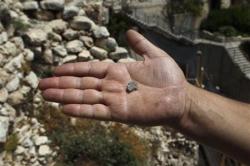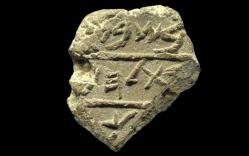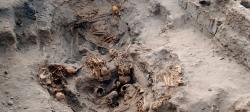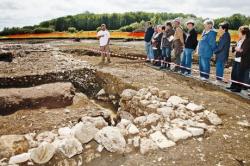INSTITUT SUPERIEUR D'ANTHROPOLOGIE
INSTITUTE OF ANTHROPOLOGY
ONLINE COURSES / COURS A DISTANCE
INSCRIPTION 2012 / Session III : Juillet 2012
REGISTRATION 2012 / Term III : July 2012
ISRAEL – 
 Jerusalem - Israeli archaeologists said on Wednesday they had discovered the first physical evidence supporting Old Testament accounts of Bethlehem's existence centuries before the town became revered as the birthplace of Jesus. The proof came, they said, in a clay seal unearthed near the walls of the Old City of Jerusalem and imprinted with three lines of ancient Hebrew script that include the word "Bethlehem". Eli Shukron, who directed the excavation on behalf of the Israel Antiquities Authority, said the seal apparently had been placed on a tax shipment of silver or agricultural produce sent from Bethlehem to the King of Judah in nearby Jerusalem in the 8th or 7th century BC. "This is the first time the name Bethlehem appears outside the Bible in an inscription from the First Temple period," Shukron said in a statement, referring to the years 1006 BC to 586 BC. The coin-sized remnant of the seal proves that Bethlehem - first mentioned in the Book of Genesis - "was indeed a city in the Kingdom of Judah, and possibly also in earlier periods", he said. Bethlehem is located on the West Bank, just south of Jerusalem.
Jerusalem - Israeli archaeologists said on Wednesday they had discovered the first physical evidence supporting Old Testament accounts of Bethlehem's existence centuries before the town became revered as the birthplace of Jesus. The proof came, they said, in a clay seal unearthed near the walls of the Old City of Jerusalem and imprinted with three lines of ancient Hebrew script that include the word "Bethlehem". Eli Shukron, who directed the excavation on behalf of the Israel Antiquities Authority, said the seal apparently had been placed on a tax shipment of silver or agricultural produce sent from Bethlehem to the King of Judah in nearby Jerusalem in the 8th or 7th century BC. "This is the first time the name Bethlehem appears outside the Bible in an inscription from the First Temple period," Shukron said in a statement, referring to the years 1006 BC to 586 BC. The coin-sized remnant of the seal proves that Bethlehem - first mentioned in the Book of Genesis - "was indeed a city in the Kingdom of Judah, and possibly also in earlier periods", he said. Bethlehem is located on the West Bank, just south of Jerusalem.
http://uk.reuters.com/article/2012/05/23/us-israel-archaeology-bethlehem-idUKBRE84M0MR20120523
ALGERIE –  Tissemsilt - Des travaux de fouilles, effectués l’an dernier au fort de "Taza" à Bordj El Emir Abdelkader (Tissemsilt), ont permis de découvrir la première pièce de monnaie en argent datant de l’Etat de l’Emir Abdelkader dans la region. Il s’agit d’une pièce de monnaie utilisée à l’époque de l’Etat algérien moderne fondé par l’Emir Abdelkader, a précisé la même source, ajoutant que le laboratoire de recherche a identifié sa date d’utilisation, à savoir en 1839. Cette pièce a été frappée probablement à Tagdemt, qui fut l’un des bastions de l’Emir Abdelkader pendant la résistance contre l’occupation française, selon le Dr Bouyahiaoui. La recherche archéologique est toujours en cours à Taza qui dispose, en plus de preuves matérielles de l’Etat de l’Emir, de pièces antiques datant de l’époque romaine.
Tissemsilt - Des travaux de fouilles, effectués l’an dernier au fort de "Taza" à Bordj El Emir Abdelkader (Tissemsilt), ont permis de découvrir la première pièce de monnaie en argent datant de l’Etat de l’Emir Abdelkader dans la region. Il s’agit d’une pièce de monnaie utilisée à l’époque de l’Etat algérien moderne fondé par l’Emir Abdelkader, a précisé la même source, ajoutant que le laboratoire de recherche a identifié sa date d’utilisation, à savoir en 1839. Cette pièce a été frappée probablement à Tagdemt, qui fut l’un des bastions de l’Emir Abdelkader pendant la résistance contre l’occupation française, selon le Dr Bouyahiaoui. La recherche archéologique est toujours en cours à Taza qui dispose, en plus de preuves matérielles de l’Etat de l’Emir, de pièces antiques datant de l’époque romaine.
http://www.aps.dz/spip.php?page=article&id_article=48744
PEROU –  Pachacamac - Le Centre de recherches archéologiques (CreA) de l'Université libre de Bruxelles (ULB) a mis au jour un tombeau exceptionnel contenant plus de 80 défunts de différents âges, à Pachacamac (Pérou). La découverte, précise le CreA, est provisoirement datée aux alentours de l'an 1000. Pachacamac, sur la côte Pacifique à quelques kilomètres de Lima, est l'un des plus grands sites précolombiens d'Amérique du Sud. Depuis près de 20 ans, le professeur Peter Eeckhout y conduit des fouilles sous l'égide de l'Université libre de Bruxelles. Au cours de l'expédition 2012, l'équipe du CreA a notamment poursuivi l'exploration d'une nécropole située face au temple de Pachacamac et a mis au jour une grande chambre funéraire de 20m2, totalement intacte et épargnée par les pilleurs. Le tombeau contenait plus de 80 défunts, squelettes et momies, accompagnés de très nombreuses offrandes: vases en céramique, animaux (chien, cochons d'Inde), bijoux en cuivre et en alliage d'or, masques en bois peint, calebasses, etc. Peter Eeckhout et ses collaborateurs poursuivront les études en laboratoire pour répondre aux multiples questions que soulève cette découverte, d'une ampleur jusqu'ici inédite sur le site, précise le CreA.
Pachacamac - Le Centre de recherches archéologiques (CreA) de l'Université libre de Bruxelles (ULB) a mis au jour un tombeau exceptionnel contenant plus de 80 défunts de différents âges, à Pachacamac (Pérou). La découverte, précise le CreA, est provisoirement datée aux alentours de l'an 1000. Pachacamac, sur la côte Pacifique à quelques kilomètres de Lima, est l'un des plus grands sites précolombiens d'Amérique du Sud. Depuis près de 20 ans, le professeur Peter Eeckhout y conduit des fouilles sous l'égide de l'Université libre de Bruxelles. Au cours de l'expédition 2012, l'équipe du CreA a notamment poursuivi l'exploration d'une nécropole située face au temple de Pachacamac et a mis au jour une grande chambre funéraire de 20m2, totalement intacte et épargnée par les pilleurs. Le tombeau contenait plus de 80 défunts, squelettes et momies, accompagnés de très nombreuses offrandes: vases en céramique, animaux (chien, cochons d'Inde), bijoux en cuivre et en alliage d'or, masques en bois peint, calebasses, etc. Peter Eeckhout et ses collaborateurs poursuivront les études en laboratoire pour répondre aux multiples questions que soulève cette découverte, d'une ampleur jusqu'ici inédite sur le site, précise le CreA.
VIDEO = http://www.rtl.be/info/belgique/societe/879789/voici-le-tombeau-exceptionnel-decouvert-par-des-archeologues-de-l-ulb-video
ROYAUME UNI - Windy Ridge - A team working at Windy Ridge off Glebe Road have found ditches containing Roman pottery on the site of what they believe was once a farm or small settlement occupied between the first and fourth centuries. Redrow said this week the finds were confined to the eastern edge of the development, on the top of the ridge. A spokesperson for CgMs said: “The current works are the second and final stage of archaeological investigations at the site and we are carefully recording the surviving archaeological remains. “The archaeological remains identified within the site are made up of a series of in-filled ditches containing Roman pottery, which form the outer parts of a small settlement site or farmstead occupied in the Roman period. “No evidence of individual buildings or other significant features has been found, and the majority of the settlement is thought to lie beyond the current development site.”
http://www.lutterworthmail.co.uk/news/business/evidence-of-roman-farm-at-controversial-windy-ridge-site-1-3853427
FRANCE –  – Linars - Le lieu-dit s'appelle La Fouillère et de récents sondages archéologiques ont révélé qu'une maison y fut construite à la fin du Moyen Âge. Une campagne de fouilles préventives (prescrite par l'État, confiée au bureau Hadès et financée par l'aménageur Cosea) a débuté à la mi-mars et se terminera le 8 juin. Cette maison en bloc calcaire fut sans doute édifiée au XIIIe ou XIVe siècle. « Cette datation repose sur l'examen attentif de fragments de céramiques. L'analyse de prélèvements de charbons et de graines nous en dira plus », a expliqué l'archéologue Christophe Calmès. La découverte n'est pas exceptionnelle mais demeure très intéressante. Il est rare, en effet, de mettre au jour un édifice de cette époque dont on distingue toutes les pièces. Cette maison rectangulaire, de plus de 20 mètres de long sur 6 à 8 mètres de large, en comptait trois. « Nous ne savons pas, pour l'heure, si c'était une ferme, le logis et l'atelier d'un artisan ou un simple lieu de stockage », a précisé M. Calmès. De son côté, Sébastien Joly, le responsable des fouilles archéologiques chez Cosea, a indiqué que les sondages sur les 302 km de la nouvelle ligne (LGV) Tours-Bordeaux avaient relevé des indices tous les 500 à 600 m, des sites intéressants tous les 1,2 km. Au total, une bonne centaine de fouilles préventives ont été prescrites par l'État. Parmi les trouvailles majeures, citons une nécropole médiévale de près de 300 sépultures à Luxé ; une villa gallo-romaine de plus de 1 000 m2, au lieu-dit L'Ouche-Torse, toujours à Luxé, et un site préhistorique avec d'importantes concentrations de silex taillés à Clérac (17).
– Linars - Le lieu-dit s'appelle La Fouillère et de récents sondages archéologiques ont révélé qu'une maison y fut construite à la fin du Moyen Âge. Une campagne de fouilles préventives (prescrite par l'État, confiée au bureau Hadès et financée par l'aménageur Cosea) a débuté à la mi-mars et se terminera le 8 juin. Cette maison en bloc calcaire fut sans doute édifiée au XIIIe ou XIVe siècle. « Cette datation repose sur l'examen attentif de fragments de céramiques. L'analyse de prélèvements de charbons et de graines nous en dira plus », a expliqué l'archéologue Christophe Calmès. La découverte n'est pas exceptionnelle mais demeure très intéressante. Il est rare, en effet, de mettre au jour un édifice de cette époque dont on distingue toutes les pièces. Cette maison rectangulaire, de plus de 20 mètres de long sur 6 à 8 mètres de large, en comptait trois. « Nous ne savons pas, pour l'heure, si c'était une ferme, le logis et l'atelier d'un artisan ou un simple lieu de stockage », a précisé M. Calmès. De son côté, Sébastien Joly, le responsable des fouilles archéologiques chez Cosea, a indiqué que les sondages sur les 302 km de la nouvelle ligne (LGV) Tours-Bordeaux avaient relevé des indices tous les 500 à 600 m, des sites intéressants tous les 1,2 km. Au total, une bonne centaine de fouilles préventives ont été prescrites par l'État. Parmi les trouvailles majeures, citons une nécropole médiévale de près de 300 sépultures à Luxé ; une villa gallo-romaine de plus de 1 000 m2, au lieu-dit L'Ouche-Torse, toujours à Luxé, et un site préhistorique avec d'importantes concentrations de silex taillés à Clérac (17).
http://www.sudouest.fr/2012/05/23/un-edifice-medieval-mis-au-jour-a-linars-722350-731.php
ITALIE – Calabre - Italian police on Friday said they were investigating 70 people for trading thousands of looted archaeological artefacts including ancient coins and vases on Internet auction site eBay. The investigation began when the police found an eBay announcement in 2009 and they tracked down a father and son team of tomb raiders in a village in Calabria in southern Italy who had dug up Byzantine, Greek and Roman burials. Police said in a statement they had seized 16,344 artefacts including bronze and silver coins, rings and ceramic vases, as well as 10 metal detectors. Most of the pieces came from the Calabria region and had been sold to private collectors. Italy’s Carabinieri police have a special department to combat the trade in looted artefacts which is still rampant in the country.
http://vancouverdesi.com/news/italy-busts-ebay-looted-artefacts-ring/
MALAISIE –  Malacca - Several archaeologists from the Heritage Department have begun research work at the site where the fort believed to be the remaining of Bastion Victoria is buried underneath. Bastion Victoria, fronting the Malacca river is part of the larger A’Famosa fortress built by Portuguese to safeguard the interest especially evading attack from the sea. The site, neighbouring Malacca’s Little India and St Francis Church,is currently a car park managed by a private concessionaire. Mohd Ali said the state government has received an official letter from the ministry, a few days ago requesting us to repeal the proposed project in a bid to conserve and unearth the relics. He said the remains of the ancient fort dating back to the era of Portuguese rule in Malacca (1511-1641) was discovered in the middle of a core zone of the heritage city. In 2007, parts of the bastion and the wall s an extension to the A’Famosa fortress left by the Portuguese were discovered during construction of the RM24.5mil Taming Sari viewing tower in Jalan Quayside next to the Malacca River. Following the find, the Federal Government issued a stop-work order to preserve the 17th century Dutch-era fortress and the 110m revolving tower project was relocated to another site. Middleburg Bastion, estimated to be 1.5km long, was a strategic military landmark in Malacca, built 250 years ago. It was built as an extension to the A’Famosa fortress left by the Portuguese.
Malacca - Several archaeologists from the Heritage Department have begun research work at the site where the fort believed to be the remaining of Bastion Victoria is buried underneath. Bastion Victoria, fronting the Malacca river is part of the larger A’Famosa fortress built by Portuguese to safeguard the interest especially evading attack from the sea. The site, neighbouring Malacca’s Little India and St Francis Church,is currently a car park managed by a private concessionaire. Mohd Ali said the state government has received an official letter from the ministry, a few days ago requesting us to repeal the proposed project in a bid to conserve and unearth the relics. He said the remains of the ancient fort dating back to the era of Portuguese rule in Malacca (1511-1641) was discovered in the middle of a core zone of the heritage city. In 2007, parts of the bastion and the wall s an extension to the A’Famosa fortress left by the Portuguese were discovered during construction of the RM24.5mil Taming Sari viewing tower in Jalan Quayside next to the Malacca River. Following the find, the Federal Government issued a stop-work order to preserve the 17th century Dutch-era fortress and the 110m revolving tower project was relocated to another site. Middleburg Bastion, estimated to be 1.5km long, was a strategic military landmark in Malacca, built 250 years ago. It was built as an extension to the A’Famosa fortress left by the Portuguese.
http://thestar.com.my/metro/story.asp?file=/2012/5/22/southneast/11316324&sec=southneast